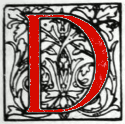
arwin’s poetry requires that the reader has a good knowledge of classical mythology, but he is also ready to offer his interpretation of some of these stories. He believed that myths were based on historical events and real people:
So mighty HERCULES o'er many a clime
Waved his vast mace in Virtue's cause sublime,
Unmeasured strength with early art combined,
Awed, served, protected, and amazed mankind.—
First two dread Snakes at JUNO'S vengeful nod
Climb'd round the cradle of the sleeping God;
Waked by the shrilling hiss, and rustling sound,
And shrieks of fair attendants trembling round,
Their gasping throats with clenching hands he holds;
And Death untwists their convoluted folds.
Next in red torrents from her sevenfold heads
Fell HYDRA'S blood on Lerna's lake he sheds;
Grasps ACHELOUS with resistless force,
And drags the roaring River to his course;
Binds with loud bellowing and with hideous yell
The monster Bull, and threefold Dog of Hell. [The Economy of Vegetation, Canto I, ll. 297-312]
Darwin’s explanatory note: “So mighty Hercules,” l. 297
The story of Hercules seems of great antiquity, as appears from the simplicity of his dress and armour, a lion's skin and a club; and from the nature of many of his exploits, the destruction of wild beasts and robbers. This part of the history of Hercules seems to have related to times before the invention of the bow and arrow, or of spinning flax. Other stories of Hercules are perhaps of later date, and appear to be allegorical, as his conquering the river-god Achilous, and bringing Cerberus up to day light; the former might refer to his turning the course of a river, and draining a morass, and the latter to his exposing a part of the superstition of the times. The strangling the lion and tearing his jaws asunder, are described from a statue in the Museum Florentinum, and from an antique gem; and the grasping Anteus to death in his arms as he lifts him from the earth, is described from another antient cameo. The famous pillars of Hercules have been variously explained. Pliny asserts that the natives of Spain and of Africa believed that the mountains of Abyla and Calpè on each side of the straits of Gibraltar were the pillars of Hercules; and that they were reared by the hands of that god, and the sea admitted between them. Plin. Hist. Nat. p. 46. Edit. Manut. Venet. 1609.
If the passage between the two continents was opened by an earthquake in antient times, as this allegorical story would seem to countenance, there must have been an immense current of water at first run into the Mediterranean from the Atlantic; since there is at present a strong stream sets always from thence into the Mediterranean. Whatever may be the cause, which now constantly operates, so as to make the surface of the Mediterranean lower than that of the Atlantic, it must have kept it very much lower before a passage for the water through the streights was opened. It is probable before such an event took place, the coasts and islands of the Mediterranean extended much further into that sea, and were then for a great extent of country, destroyed by the floods occasioned by the new rise of water, and have since remained beneath the sea. Might not this give rise to the flood of Deucalion? See note Cassia, V. II. of this work.
Last modified 27 December 2016